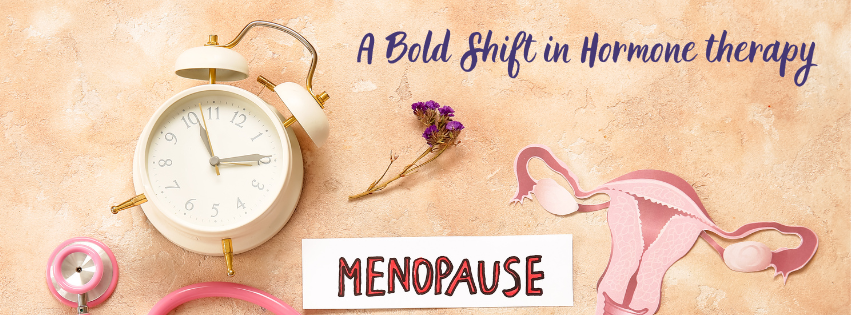A Bold Shift in Hormone Therapy and Women’s Health:
- Shelly Bergeron
- Jul 22
- 3 min read

It’s About Time.
If you’ve ever dealt with vaginal dryness, painful sex, bladder irritation, or recurring UTIs and felt like no one took it seriously… this is for you.
For the first time ever, we now have official clinical guidelines for Genitourinary Syndrome of Menopause (GSM)—and it’s a huge win for women in midlife and beyond.
This isn’t just another medical update. It’s a bold step forward in a larger conversation: women deserve better care, better options, and better information when it comes to menopause, hormones, and long-term health.
What Is Genitourinary Syndrome of Menopause (GSM)?
GSM is the updated medical term for what used to be called “vaginal atrophy”—but it’s much more than that. It refers to a collection of symptoms caused by a decline in estrogen and other sex hormones during menopause, affecting the vaginal tissue, vulva, urethra, and bladder.
Common GSM symptoms include:
Vaginal dryness, irritation, or burning
Pain with sex (dyspareunia)
Increased urinary urgency or frequency
Recurrent urinary tract infections (UTIs)
Bladder discomfort
Decreased libido or sexual response due to pain
Up to 80% of postmenopausal women experience symptoms of GSM—but until now, many were dismissed or misdiagnosed. Women were told it was just aging, or worse, just in their head.
Now, the science and the clinical community are finally catching up.
Why These New GSM Guidelines Matter
In 2024, the American Urological Association, in collaboration with The Menopause Society and the Sexual Medicine Society of North America, released the first-ever official clinical guideline for diagnosing and treating GSM.
That’s a big deal!
It brings clarity and legitimacy to something millions of women have endured silently. It also opens the door to evidence-based, patient-centered options that include both hormonal and non-hormonal treatment strategies. But this isn’t just about comfort. It’s about protecting your quality of life and your long-term health.
GSM Isn’t Just Annoying—It Can Be Dangerous
Chronic vaginal and urinary symptoms are not just inconvenient—they can become serious health concerns if left untreated.
Here’s what the research shows:
UTIs cause nearly 200,000 deaths globally each year
In older adults, urosepsis (a type of sepsis that begins as a urinary infection) has a mortality rate of up to 33%
Repeated antibiotic use for UTIs contributes to antibiotic resistance, which makes future infections harder to treat
But here’s the good news:💡 In women over 55 with recurrent UTIs, using vaginal estrogen has been shown to cut the risk of sepsis nearly in half—and reduce mortality by 73%
That’s powerful. And yet, many women—and even many providers—don’t know this.
Hormone Therapy and the Vaginal Microbiome: It’s All Connected
This GSM guideline is part of a much bigger picture.
In my earlier post, “A New Terrain in Women’s Health”, I shared why the vaginal microbiome is an essential but often overlooked part of female health—especially in after the age of 40.
Estrogen plays a critical role in supporting the vaginal microbiome, helping maintain a healthy pH, strong mucosal lining, and robust defense against pathogens. When estrogen levels decline, this microbial balance can shift, leading to inflammation, infection, and discomfort.
So when we talk about GSM, we’re also talking about:
Vaginal pH
Lactobacillus diversity
Microbial resilience
Hormone signaling
Vaginal estrogen isn’t just about restoring moisture—it helps rebalance the vaginal terrain, reduce infections, and protect overall genitourinary health.
It’s one more reminder that the female body is deeply interconnected, and our care strategies need to reflect that.
The Bigger Shift in Menopause and Hormone Health
These new guidelines are a milestone not just because they validate vaginal and urinary symptoms—but because they’re part of a broader shift in how we talk about menopause, hormone therapy, and healthspan.
For too long, women were left to figure this out on their own—or told they just had to “live with it.” We now know better.
Today, more women and practitioners are exploring:
Bioidentical hormone therapy
Non-hormonal options for symptom relief
Vaginal microbiome testing
Lifestyle and nutritional support for genitourinary health
It’s not one-size-fits-all, but it is time to talk about it—and take action.
What You Can Do Now
If you’re experiencing any of the symptoms listed above—or if you’ve ever felt dismissed, frustrated, or unsure of what’s “normal”—this is your sign to take action.
You don’t have to wait until symptoms become disruptive or debilitating. You don’t have to go it alone.
As a functional medicine health coach, I help women take back control of their health with:
Education
Empowerment
Personalized support
Collaboration with trusted providers when needed
✅ Here’s how to take the next step:
📞 Book a free Roadmap to Relief call and let’s map out what’s going on and find real, workable solutions with support along the way.




Comments